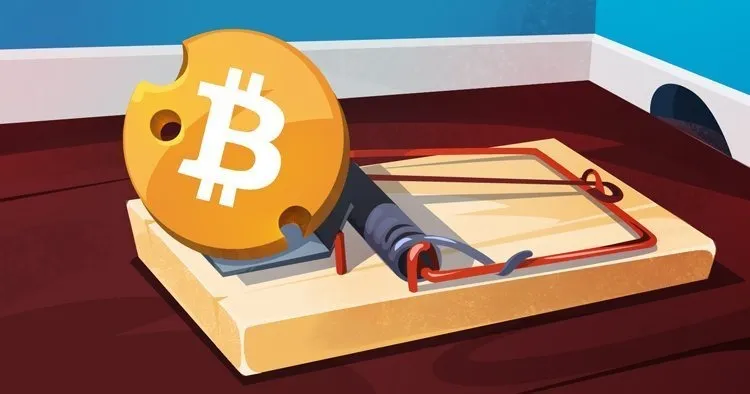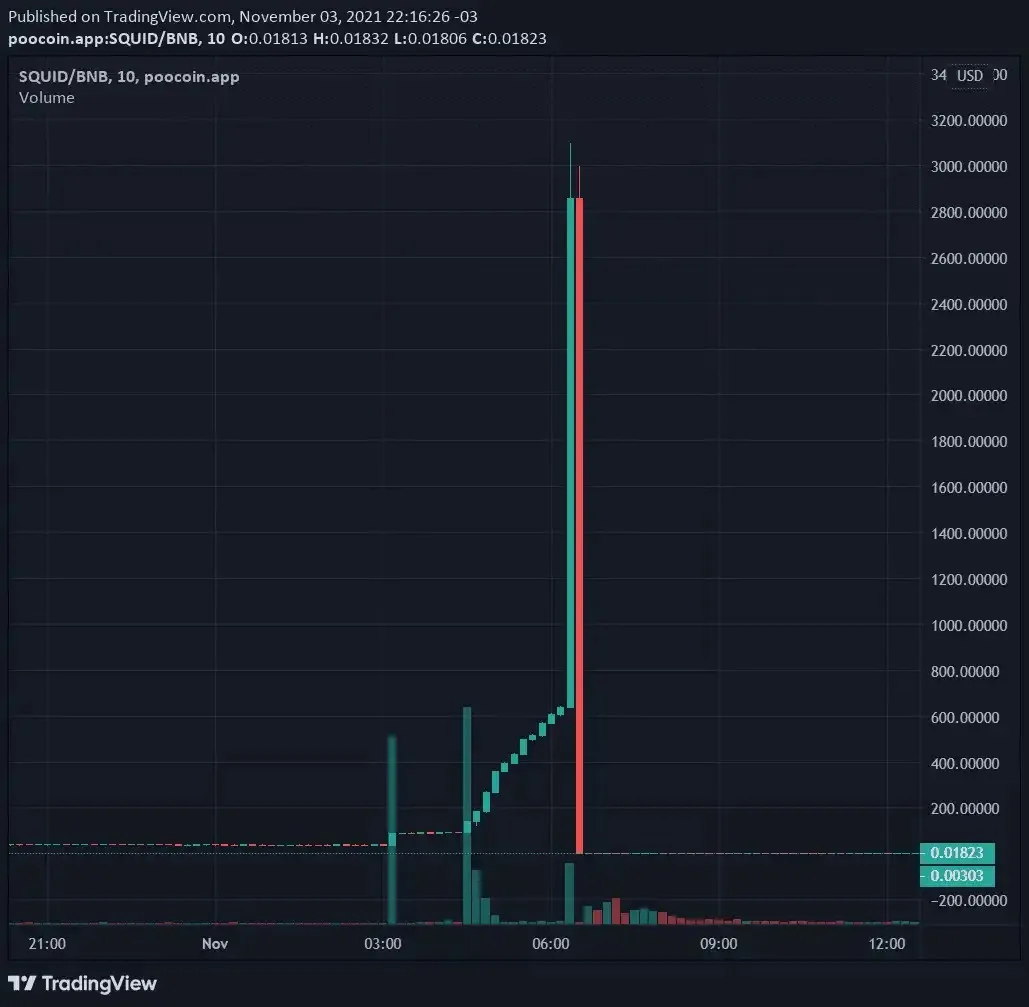
Cryptocurrency scam
The world of cryptocurrencies is full of opportunities and, unfortunately, different types of dangers. One of the most serious threats remains cryptocurrency scam, which both beginners and experienced traders/investors fall for.
What is Cryptocurrency Scam

Cryptocurrency scam is a form of cryptocurrency fraud, where criminals create fake projects to swindle money from gullible users. Such scams can take many forms, from fake ICOs to theft through crypto wallet hacking.
As a rule, the goal of any type of scam is the same - to make people transfer funds into the hands of scammers under the guise of “investment”, “trading” or “passive income”.
Popular types of scam in crypto
There are many varieties of crypto scam, here are the most popular ones - fake ICOs and investments in fake projects, Cryptocurrency pyramids, phishing attacks, crypto wallet scam, rug pull, arbitrage scam.
Fake projects and ICOs are created at the expense of fake teams and sites, pyramid schemes promise unrealistic passive income, copies of famous wallets steal syd phrases and funds after installation, and scams in arbitrage and rag pools are built on primitive fundraising and their subsequent theft.
Examples of major scams

OneCoin is one of the most famous examples of token scams. The project raised billions of dollars worldwide, but the coin didn’t even exist on the blockchain.
BitConnect is a classic cryptocurrency pyramid scheme that collapsed in 2018.
How to distinguish a reliable project from a scam project

Distinguishing a reliable cryptocurrency project from a scam project is not an easy task, especially for beginners. Nevertheless, there are already some basic signs by which you can recognize that you are facing a potential crypto scam.
First of all, you should carefully study the technical documentation of the project, known as Whitepaper. In serious projects, it will be detailed, with clearly defined goals, economic model, development stages and technical features. If the document is vague, lacks specifics, or consists of marketing slogans, this is the first red flag. Serious teams do not hide details and always explain exactly how the product works.
The next important aspect is the openness of the team. Reliable projects do not hide the identity of developers, specify their experience and previous achievements. If you can’t find information about the team or when you try to check it, you find out that the names are fictitious - most likely, you have encountered a cryptocurrency scam. Lack of mentions in professional social networks like LinkedIn or fake photos also indicate a cryptocurrency scam.
The project’s activity in the public space also matters. Reliable initiatives maintain social networks, publish regular updates, get in touch with the community, and answer questions. If the project’s communication channels are silent, comments are deleted, and communication is limited to anonymous Telegram bots, it may speak of a cryptocurrency scam.
One of the fundamental criteria is the audit of smart contracts and code. Most honest projects have external audits from independent companies. The results of such audits are usually published in the public domain. The absence of an audit is another reason to be wary, especially if the project is raising funds from investors or launching tokens.
It is equally important to pay attention to tokenomics. Excessive centralization of tokens in the hands of developers may indicate preparation for a rug pull - a sudden disappearance with money. Projects where creators control 80-90% of token issuance are a clear sign of potential fraud. You can check such data with the help of blockchain analytics, available on specialized platforms like Ethereum scan, Tron scan and others.
It is worth mentioning promises separately. Reliable projects do not guarantee profits, especially high and in a short period of time. If you are told that “you will definitely earn”, “enter now and get +300% in a week” - in front of you is almost certainly a cryptocurrency scam. Real blockchain initiatives are focused on long-term development, not on raising money quickly.
It’s also important to check code activity on GitHub (if it’s a technical project) and real partnerships. If big companies are mentioned - check if there are official mentions from their side. How to check a token? Real tokens can be found on popular aggregators with transparent trading history, while fake tokens are often traded only on little-known DEX platforms with artificial volume.
In general, if you can’t get answers to your questions, if the project raises even the slightest doubt, and you are not sure how to recognize cryptoskam, it is better not to invest. The crypto market offers a lot of opportunities, and real projects always stand the test of transparency, openness and the presence of a real product.
How to protect yourself from scams

If you are serious about storing cryptocurrencies and use trading bots, paid analytics or external platforms, it is worth building your digital protection strategy in advance. It should start with the right choice of storage methods and end with strict control over the transfer of access via API keys.
Safe storage of cryptocurrencies
The main goal of any cryptan is to maintain control over your assets. Therefore, the first thing you should do is to ensure that your cryptocurrencies are stored securely. Storing assets on an exchange is a temporary and risky solution. Exchanges can be hacked, blocked, or simply disappear. This has been especially common with young or offshore platforms, which later turned out to be followed by a cryptocurrency scam.
The most reliable method is to use hardware wallets. They store your private keys outside of internet access, making cryptocurrency wallet hacking technically impossible unless you hand over the data to the attacker in person. At the same time, it is extremely important to handle the cid-phrase (recovery phrase) correctly. It should be written down on paper and stored in an inaccessible place. Never photograph it, copy it to the cloud, or send it by mail. Losing the passphrase means losing access to the funds completely, and compromising it is a direct path to theft.
Additionally, use trusted open source wallet apps. Trusted wallets are not only a matter of convenience, but also a matter of trust. Scammers are increasingly releasing scam cryptocurrency wallets that look like the real thing, but are actually designed to steal assets right after the first deposit. This type of deception is especially relevant in Telegram, where fake bots and pseudo-apps are actively spreading.
Always check the addresses of sites from which you download wallets, install anti-virus and anti-phishing extensions, do not follow links received from unknown contacts. Be especially attentive to pages that require you to enter a passphrase or private key - this is a hundred percent scam, no one from the project team will ever ask you to do this.
Using bots and analytics
Trading bots and analytical services are often used in modern trading. They help to automate trades, monitor the market, and manage risks. However, this is where a new risk zone arises - transfer of API keys to third-party services. Not every user thinks about what an API is in cryptocurrency and how much it matters what rights they grant when connecting a bot to their exchange account.
If an API key has permission to withdraw funds, an attacker, having obtained it, can completely clean out your account. Even if the key is limited to trading only, it can be used for manipulation, for example, buying tokens at unfavorable prices. Such cases have already happened on well-known platforms, which turned into cryptocurrency fraud and loss of funds of hundreds of users. And although these platforms are still working, trust in them has been seriously undermined, precisely because of the leakage of keys and the lack of a transparent system of protection.
To avoid becoming a part of such a story, choose services where security is realized at the system level. Veles platform - provides tools for automated trading and analysis, where only keys are used for connection without the right to withdraw, and the keys themselves are encrypted on the client’s side. In addition, access to the account is protected by two-factor authentication and activity monitoring algorithms. This is an example of secure trading, where the user retains control and still gets all the benefits of automation.
It is also important to realize that many investments in fake projects masquerade as “analytics platforms”. They issue fake signals, offer subscriptions, and then disappear with users’ money. Before trusting the service - study the reviews, check the company registration, security policy, data storage conditions and, most importantly, what exactly your data you are transferring.
What to do if you are caught by scammers
Even an experienced user can fall for a crypto scam. Situations vary: someone believed in the promise of “quick money”, someone connected an API key to a fake platform, someone entered a cid phrase on a fake site. Regardless of the method, if you are victimized, it is important to act quickly and cold-bloodedly.
The first thing to do is to stop any activity on the platform where the incident occurred. If you have transferred API keys, immediately delete them via the exchange settings. This will block further access and at least stop the automatic actions of the attackers.
If your cryptocurrency wallet was hacked or you lost control over the asset, transfer the remaining funds to a safe address. You should do this from another device that is not connected to the current session.
If you accidentally send a cid phrase, consider the wallet completely compromised. Create a new wallet, transfer assets to it (if there are any left) and stop using the old address immediately. Do not hope that the funds will remain safe - crypto scams are usually weaponized through automated scripts, and if your phrase has “leaked” somewhere, the counter has gone by minutes.
The second step is to document all evidence. Take screenshots of correspondence, transactions, addresses, sites you clicked on. This is important not only for a possible investigation, but also for filing complaints to regulators or exchange tech support. If you transferred funds to an exchange, its security service may be able to help block fraudulent addresses, especially if they are already known. Several exchanges partner with analytics services and track scammers by address.
The next thing you can do is notify the community. Write about it in themed Telegram chats, Reddit, X (former Twitter), Discord. Often scammers use the same schemes and addresses repeatedly, and your alert can save others. Plus, if you’ve been victimized by an organized scheme, the massive exposure may attract media attention or even law enforcement.
If the damage is significant, it makes sense to contact your country’s cyber police or financial crime organizations. Some jurisdictions, especially in Europe and the US, have separate structures to deal with cryptocurrency fraud. Yes, the chance of recovering funds is slim, especially if the assets went to decentralized addresses. But in the case of mass incidents, as was the case, for example, with fake ICOs or well-known cryptocurrency pyramids, investigations are still launched, and sometimes even lead to the blocking of assets on centralized exchanges.
Another important step is to audit all your devices and accounts. Install an antivirus, check for malware, change passwords to all crypto services and emails. Even if you have lost money, the main task now is not to lose even more. Cryptocurrency security is first and foremost about minimizing the consequences.
Finally, and most importantly, draw conclusions. Is it possible to lose money on cryptocurrency? Yes, especially if you trust strangers, ignore basic security hygiene, and believe in quick profits. Every case of crypto scam should be a lesson learned. Remember: crypto scam is not an accident, it’s a well thought out strategy of deception, and your best defense against it is knowledge and critical thinking.
FAQ
1. How to understand if a coin is scam or not?
Check the documentation, team, audit and activity of the project. If something seems suspicious - most likely it’s a cryptoskam.
2. Is it possible to lose money on cryptocurrency?
Yes. Especially if you don’t follow cryptocurrency security and trust your money to questionable projects.
3. What is a scam in crypto?
It is a scam where you lose money as a result of a fake project, crypto wallet hacking or manipulation of your API keys.
4. How not to get scammed?
Don’t believe in “fast money”, research projects, don’t share your cid phrase with anyone, check every link and offer.
5. Cryptocurrency scam - are there proven ways to avoid it?
Yes. Proper storage, analytics, trading bots from a trusted developer (such as Veles), and basic digital hygiene.